

  |
|
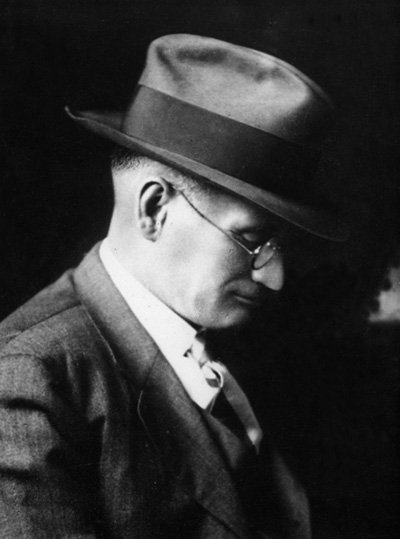
|
Name: William Edward Burgess Date: ca. 1920 Image Number: B419cdB28 Comments: William Edward Burgess (1871-1935) was a photographer and historian, who lived his adult years in Scottsville, Virginia. He was known to all as 'Willie' and worked out of Idylwood, his combination home and photo studio located in the eastern part of Scottsville that lies in Fluvanna County. An avid photographer since his teenaged years, Burgess carried his large box camera and tripod everywhere. He seemed determined to photograph everything he encountered, often appearing as if from thin air to take a family portrait or record a town event. Sometimes Burgess had to beg his busy subjects to stand perfectly still for the long exposures required for successful early photographs. But fortunately for historians, many Scottsvillians granted Burgess the time he needed photographically to capture the grace and ambience of town life during the early 1900's. Burgess was a gifted photographic technician. His studio, located under a solid glass roof in his Idylwood home, contained state of the art equipment. And when the photographic tools he needed weren't available, Burgess improvised. He washed his photo prints in a special, handmade box, which he immersed in the swift Hardware River waters near his home. Because of his thorough print washing, Burgess photographs retain their archival quality more than 100 years later. Burgess also was fascinated with broad photographic landscapes, initially piecing photos together to create a representative panoramic view. Soon Burgess owned an early panoramic camera, which he used to record such events as this 1890 race track scene at Scottsville's James River Valley Fair grounds. Additional panoramic photos by Burgess may be found in the 'Business' section of this collection; they may be recognized not only by their length but also by the characteristic bend in each scene's middle caused by lens distortion. 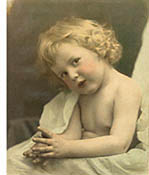
Deeply artistic in temperament, Burgess loved beauty, saw it everywhere, and strove to capture it unblemished in his photographs. Particularly representative of his artistry are the hand tinted portraits Burgess created from his black and white photos. He used a special desk with attached seat that allowed him to pull a glass covered top into his lap with the subject photo affixed for tinting. At this desk, Burgess tinted his portraits with color brush strokes so delicate that the resulting works often are mistaken for oil paintings. Shown here is an exquisite hand tinted photo of his son, William Harold, which Burgess completed about 1910. Other examples of his hand tinting talents are included in the 'Portrait' section of this collection.
On July 20, 1935, William Edward Burgess died of a heart attack during a photo shoot in Altavista, Virginia. He was buried besides his wife and young son in the Burgess Family Cemetery in Locust Grove, Virginia. William Edward Burgess: Poet-Historian with the Camera by L. H. Halliburton The Sabre, Fork Union Military Academy, Fork Union, Virginia, December 18, 1974
One of the ironies of history is that some individuals who contribute significantly to their times, and inevitably to posterity as well are nevertheless forgotten. On occasion these contributions are quite deliberate; sometimes, totally unconscious. Whatever the case, it seems especially poignant that anyone who adds dimension to the portrait of man, acceleration to his advance through time, or grace to the manner in which he exists as an individual in his brief earthly sojourn, should be consigned to the dustbin of the past. William Edward Burgess, a native of Fluvanna County, is one of those persons who should be remembered for a special legacy he left behind when he died thirty nine years ago last summer; instead he is virtually forgotten today. It is the purpose of this brief article to preserve certain basic data about this sensitive, vivid personality. In a larger sense, an effort will be made to evaluate the accomplishments of his life which survive in present times. To rescue from near oblivion any meaningful life's work is surely a worthy task. William Edward Burgess, photographer extraordinary and genuinely a fine poet, was born in 1871 at Locust Grove, the Burgess family plantation on the Hardware River between Fork Union and Scottsville. The house, surrounded by enormous boxwood and handsome trees, still stands today in remarkably good state of preservation. He was the son of Pleasant M. Burgess (1833-1906) and Sarah Elizabeth Clarke Burgess (1838-1913), solid and hard-working citizens of an earlier day when agricultural pursuits occupied first place in the attentions, interests, and exertions of Fluvanna County. There were two brothers and four sisters in the Burgess family: William, Garnett, Cornelia, Helen, Laura, and Florence. Mr. Bernard A. Burgess, prominent citizen, banker, and churchman of Fork Union, was a cousin of the Burgess family of Locust Grove. In the years after the Civil War, public schools were only rarely found, and education was hard to come by. The Burgess children traveled daily by horse and buggy to a one-room schoolhouse at Central Plains, several miles from the family plantation. In winter, a horse-drawn sleigh was used. Mrs. Katherine Pitts Phillips of Scottsville reveals William Burgess's sense of humor and mischievous attitude in a story she tells about one of these journeys from the farm to the school. "Willie," as he was familiarly known, was driving the sleigh one winter's day through deep snow. Enjoying the scaring and teasing of other children, he would constantly cause the horses to carry the sleigh to the very edge of deep snowbanks, then pull them back to safety. Suddenly he went too far; the sleigh was up-ended; and the children, carrying their lunches and individual silver spoons into the icy banks. No one was hurt, and "Willie" was enchanted with the misadventure. Despite a mad scramble, some of the silver spoons were never found, it is said. As a very young man, William E. Burgess married Miss Gentry Cornet (1872-1912); they had three children: Lawrence, George, and William Harold. George, born in 1903, died suddenly and tragically in 1913 at ten years of age, only one year after the death of his mother. This double blow saddened Mr. Burgess for the rest of his life. He retained a housekeeper to help him rear his children and remained a widower during the twenty-three years until his death in 1935. Apparently while still a teenager, William Burgess became interested in photography. He used a large box camera upon a tripod and took pictures while standing behind it with a black hood over his head and over part of the camera. According to Edward L. Dorrier, nephew of Mr. Burgess, he built a special box in which to wash his prints and placed it in the swift waters at the edge of the Hardware River near his home. The constantly flowing water through this box did the job of much more sophisticated equipment deemed necessary today. Mr. Burgess was considered by many to be a fanatic about photography. It seems incredible, but it is nonetheless true that he photographed almost every home, every store or other business enterprise, and eery scenic or historic spot in Central Virginia, especially those in Fluvanna and Albemarle Counties. In addition, he took thousands of pictures of family groups, fraternal organizations, club gatherings, meetings of Civil War and World War I veterans, weddings, family reunions, funerals, floods, and literally almost anything else one could name, including wildlife! His pictures of the campus and buildings of Fork Union Military Academy during this institution's earliest years are beautifully done; photographs of Academy organizations made fifty or sixty years ago depict the features of each member's face as clearly as one could wish or hope for. Mr. Burgess also made pictures throughout the rest of Virginia, especially in the Natural Bridge area and around Altavista where his great friends, the Lane brothers, lived. Many of these pictures were printed and sold as postcards; all of them were carefully copyrighted. Collectively, his photographic output is a vigorous, graphic, detailed history of Central Virgina, at least for years 1900 through 1935. A book could be written based upon them. Mr. Raymon Thacker, Mayor of Scottsville, Virginia, was the executor of Mr. Burgess's estate. In an intervview with this writer, Mayor Thacker indicated that Mr. Burgess left to his estate 485,000 postcard views of various places and groups -- many in color -- and more than 20,000 pictures, many beautifully mounted. Some were given to the University of Virginia's Alderman Library as a special historical collection under the Burgess name, many now belong to the Scottsville Museum, and Mr. Thacker retains a large number for his personal collection. Fluvanna and Albermarle County families still treasure a few of the Burgess postcards which have somehow been saved through the years. Mr. Burgess spent most of his adult years as a citizen of Scottsville, Virginia, about six miles from his birthplace at Locust Grove. Here he maintained and operated his widely-known Idylwood Art Studio, located in a house on a high hill overlooking the James River and in that part of the town of Scottsville which lies in Fluvanna County. The large rambling house in a part of which the Idylwood Studio was situated under a solid glass roof was also his home where he lived and reared his children. The studio was particularly elaborate and featured the very best of equipment for the times. The Richmond Times - Dispatch in a featured article for Sunday, June 6, 1909, referred to Idylwood as "a unique establishment, the like of which exists nowhere else in this country." Articles about Idylwood appeared also in many small-town newspapers and journals throughout Central Virginia. In one article, mr. Burgess gave his own, highly-personal opinion of his combination home and photographic studio: "From Idylwood a magnificent view of the Blue Ridge Mountains is obtained, the James River and valley, the town, and the noted Horseshoe Bend. The view from Idylwood is a refreshment for the soul, a treasure for the memory." (December 22, 1916) Deeply artistic in temperament, a man who loved beauty and saw it everywhere, Mr. Burgess lived in his own creative environment. He wrote beautiful poetry -- romantic, nostalgic, conservationist, patriotic, religious, and futuristic -- and newspapers, journals, and magazines throughout Virginia and elsewhere printed his verse, accompanied by laudatory comment. He published at least two anthologies of his poetry, perhaps more. For many years he leased, operated, and managed the Victory Theatre in Scottsville where numerous cultural events which he sponsored were held and where he introduced silent movies and early sound films. A lifelong Baptist and a member of Fluvanna Baptist Church, he attended services regularly and reared his children in the tradition of a church-approved, God-fearing orientation toward life and its vicissitudes. Some of his friends and acquaintances considered him to be eccentric in many aspects of his life style, though never harmful to anyone, of course. Because of his absolute determination to photograph everything he encountered, animate or inanimate, even his relatives at times regarded him as a "pest." People had to stand perfectly still for long periods of time in order that the early photographs might be successful. Many individuals had to be importuned or begged to do so because they preferred to do other things, hated to "waste" time, and lacked an appreciation for the value of Mr. Burgess's work, in terms of the future at any rate. Despite his difficulties, William Edward Burgess worked on and on, his enthusiasm for his photography and his poetry a vital, driving force until the end of his days. He died in Altavista, Virginia, of a heart attack on July 20, 1935, in the sixty-fifth year of his life. Typically, he was in Altavista on a mission to photograph several places and groups of people. Today he sleeps in the Burgess Family Cemetery at Locust Grove, beside his wife and young son. The cemetery, located in a small grove of trees on a steep hill, overlooks the Hardware River at a point where Highway 6 West crosses it on Temperance Bridge, once a wooden covered structure. William Edward Burgess was a historian, whether he realized it or not. Although many of his photographs have been lost -- victims to floods, fires, human carelessness, or the wear of time -- enough remain to tell us in detail how people lived and what they cared about in the early years of the twentieth century. This is a significant legacy, grist for the historian's mill, and deeply appreciated by many of us living today. Let us give thanks for the life of W.E. Burgess, for his sensitivity to the special ambience of his time in history, and for his photographs and poems highlighting and preserving the long ago. Life in Black and White
by Ruth Klippstein
Scottsville Monthly, June 17-July 21, 2011
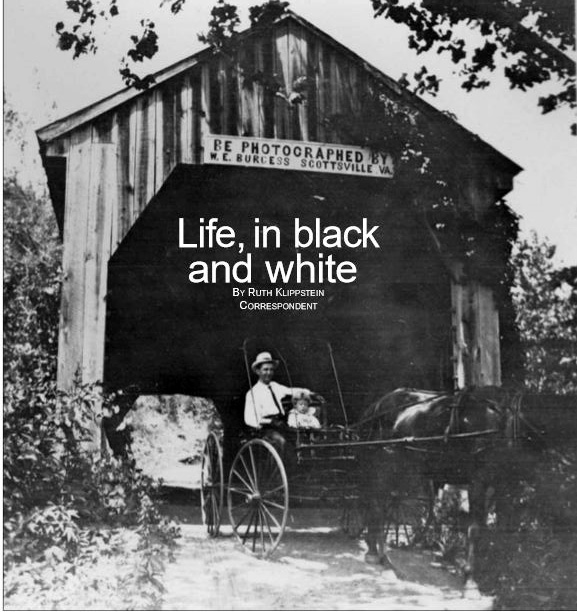 William Burgess captured this 1911 photo of Walter Dorrier with his 5 yr. old son, Edward, at the Temperance Bridge
on the Hardware River
Photo Courtesy of Irene Dorrier (IED04cdIED08) "We cannot offer you 'SPECIALS' in work," ran a June 29, 1911 ad in the Scottsville Enterprise newspaper. But photographer William Burgess of Idylwood Studio promised "Our Work is 'Special' all the time." As photography was still beginning its broad--and continuing--effect on our world, one practitioner brought it on a daily basis to Scottsville. William Edward Burgess, often known as Willie, and more recently called a "poet-historian with the camera," was born in 1871 at Locust Grove, his family's home on the Hardware River about six miles from Scottsville towards Fork Union. His father was Pleasant Madison Burgess, his mother, Sarah (Sally) Clarke; there were eight children in all, two of the girls the first and second wives of Captain John Pitts of Scottsville. This information and these Burgess family photographs come from Irene Dorrier Schneider, whose father, Scottsvillian Edward Dorrier "always referred to Burgess as 'Uncle Willie.' Burgess was," Irene thinks, "somewhat eccentric, certainly nice looking, and very focused on his work." Irene spread her trove of photographs on a table and referred often to family genealogy that she's amassed. "The Pitts, Dorriers, and Burgesses were all interrelated in different ways," she says. Someone once observed, "You have a tangled family!" Irene describes the Burgesses as "farmers, but fairly well-to-do." The children "travelled daily by horse and buggy to a one-room schoolhouse at Central Plains," according to L.H. Halliburton in a December 1974 article he wrote with Bob Spencer for the Fork Union Military Academy "Sabre." Willie, she gathers, "was spoiled." Irene says that one daughter, deaf since childhood, was later sent to art school in Pennsylvania. This was Irene's grandmother, Laura Adelaide, who continued to paint in watercolors, later oils, all her life, including a picture Irene displays of Willie's house and studio, Idylwood--on Driver's Hill, between the current Albevanna Spring Road and Route 6, now burned to the ground. Three of the Burgess siblings, Irene says, were artistic, but she does not know any family history suggesting why or how Willie picked up photography, though it is assumed he was self-taught, and as a teenager, probably learned from books. His work, however, was not the first in town, as Fannie Patteson, in her 1934 manuscript, "Childhood Days in Scottsville, Virginia, 1860-1870" says: "About 1869 came the Floating Gallery, and was anchored near the bottom of our garden in a wide part of the canal called the basin. That was the first we knew of photography, and everyone far and near hastened for a sitting... Before that time, Mr. Ellis was our dependence for 'likenesses,' which was easier to say than Daguerreotype." Photo courtesy of Irene Dorrier Schneider Willie, his brother Lawrence wrote in a letter, 1987, now in Irene's possession, graduated from Massey Business College in Richmond, "with a degree in accounting and was employed on graduation by the C&O railway in their Washington, D.C. office. During the westward expansion of the railroad to Chicago, he was stationed at various construction locations to monitor the activities of construction contractors. During this time, he was actively pursuing his avocation of amateur photography. On completion of the railroad expansion, about 1905, he returned to Scottsville and established a professional photography business, with part time accounting employment with the Pitts and Morris Construction Company, contractors for the last railroad job on the line from Bremo Bluff to Palmyra to Gordonsville." Burgess collected a variety of photography equipment, some of it "state of the art." The story is often written of the "special box" he built to "place in the swift waters at the edge of the Hardward River near his home" to wash chemicals from his prints. Halliburton credits Irene's father, Edward Dorrier, with describing this; apparently Willie's son, William, would help with this work. The Scottsville Museum's website on Burgess notes that his prints retain their archival quality "more than 100 years later." Jack Hamner thinks that Burgess's Scottsville photos "were extremely instrumental in putting Scottsville on the map, promoting the area. People got to know about us at a time when there weren't a lot of other means to circulate information." "he's very collectible," says Bob Spencer, who counts this "pioneer of photography" as kin. "There's a great interest still in his postcards." Burgess would show up at all events--the earliest photograph in the Museum's Burgess collection is of 'Race Day, 1890' at Scottsville's James River Valley Fair. In 1911, he recorded the Gault camping party setting off, boys in knickers, women in broad-brimmed hats and middy blouses, for a week of tent living and outdoor activities near Schuyler. A circa 1898 print in Scottsville Town Council Chambers at the Municipal Building shows a lamp lighter on Valley Street, looking north along the dirt-packed road. Bob Spencer says Willie would also come to family parties with his tripod and big box camera, flash powder ready to be ignited, and ask everyone to pose, sitting still for the long time required for each exposure. Burgess was, in fact, sometimes considered "a pest." John Randolph Phillips, in "Of Town and River," 1976, says, "In his sentimental, delightful, and sometimes exasperating way, Mr. Willie Burgess was one of Scottsville's characters, with a capitol C." 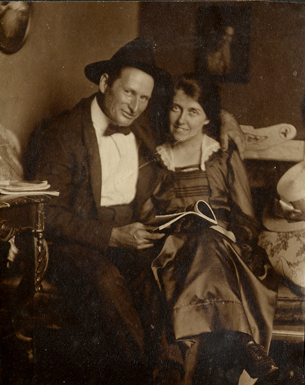 William Edward Burgess and his wife, Gentry, ca. 1900 Photo courtesy of Rita Burgess (RB10cdRB01) 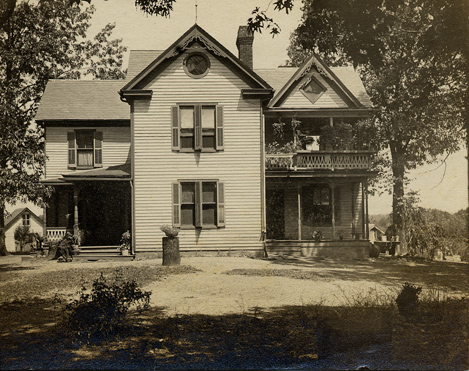 Idylwood, home of William Edward and Gentry Burgess Photo courtesy of Rita Burgess (RB36cd03) 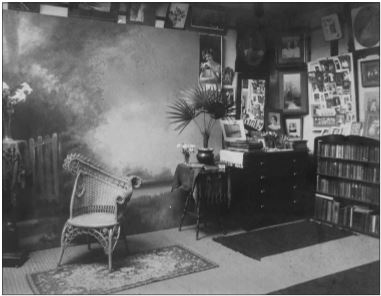 Interior of Burgess's photo studio at Idylwood Photo courtesy of Irene Dorrier Schneider 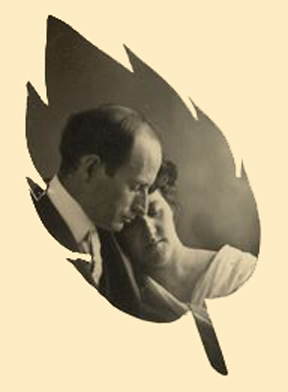 William Edward Burgess and his wife, Gentry, ca. 1910 Photo courtesy of Irene Dorrier Schneider Willie Burgess with his sons, Lawrence and Harold, at Locust Grove Photo courtesy of Irene Dorrier Schneider Besides the 486,000 postcard views and 20,000 pictures he left at his death, by heart attack on a photo shoot at Altavista, 1935, Burgess published "at least two anthologies of his poetry, perhaps more." As his brother Lawrence writes, "he was a vivid and sensitive personality." William Edward Burgess became the operator of Victory Hall when it opened in 1920, owning the franchise to show movies there--silent films with live musical accompaniment and early talkies--and other cultural events. The housekeeper Burgess hired after his wife's death in 1912 was Bertha Mayo, who later operated the player piano for Burgess's silent movies at the Victory Hall. William Edward Burgess passed away on July 20, 1935, dying of a heart attack during a photo shoot in Altavista, Virginia. Mayor A. Raymon Thacker, a family friend, became a "reluctant executor" of Burgess's estate at the request of Burgess's sister, Helen Pitts, selling his photographs widely to raise money for the family. Currently, a grandson lives in Lake Monticello and a great grandson in Charlottesville. Burgess's photographs offer us a vista into history: how Scottsville saw itself, what it held important, and details we can still reference in maintaining the integrity of the town's architecture. Hairstyles and clothing have changed, the covered bridges are gone, but we can still see, thanks to Burgess, attitudes and places from the past, images that are always with us. (Great thanks to Irene Dorrier Schneider for suggesting this essay, for providing the facts and the photographs. And to her husband, Fred, for technical assistance and breakfast. Read and see more at the Scottsville Museum website, smuseum.avenue.org .) The first three photos were provided by A. Raymon Thacker of Scottsville, Virginia. Raymon served as Scottsville's mayor for over 30 years and was a close friend of Willie Burgess. The photos of the Burgess wedding, Idylwood, and William and Gentry Burgess were provided by Rita and William Burgess of Palmyra, Virginia; William is the grandson of William 'Willie' Edward and Ellen Gentry (Cornett) Burgess. The photos of William Burgess at the Temperance Bridge, the Idylwood Studio advertisement, the interior of the Burgess photo studio at Idylwood, and the photos of William Burgess with his wife, Gentry, and with his sons, Lawrence and Harold, were provided by Irene Dorrier Schneider of Charlottesville, VA. Copyright © 2018 by Scottsville Museum |
|
|
|
Museum
Archive
Business
Cemeteries
Church
Events
Floods
For Kids
Homes
Portraits
Postcards
School
Transportation
Civil War WWII Esmont Search Policy |
||||
|
Scottsville Museum · 290 Main Street · Scottsville, Virginia 24590 · 434-286-2247 www.avenue.org/smuseum · info@scottsvillemuseum.com Copyright © 2019 by Scottsville Museum |
||||